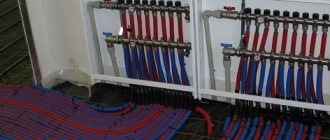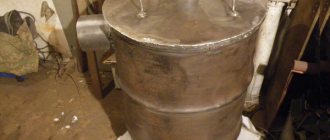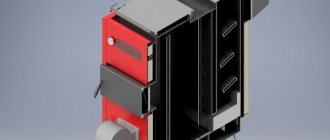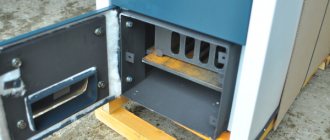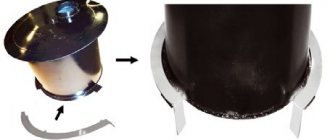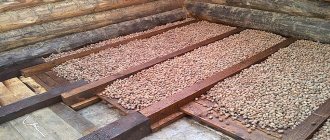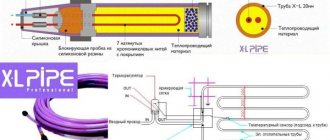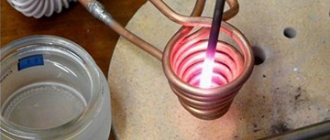How to choose a solid fuel boiler for heated floors
The choice of boiler depends on the size of the house, the permanent residence in it and the volume of the room where the heating equipment is located. You can use any solid fuel boiler for underfloor heating, which was installed for heating through a radiator system.
Schematic installation of the boiler. Photo source: torg.ua
It is enough to install additional equipment that ensures safe operation, taking into account the characteristics of solid fuel combustion.
Heated floor installation
The main condition when installing the system is that heat must go up, not down. To do this, you have to make a heat-insulating layer, which is made from any material intended for this purpose. It is better to give preference to proven insulation materials; just go to the construction forum and look at the names.
Operating principle of heated floors
Regardless of what material will be used as insulation, the following conditions must be met:
- The thermal resistance of the insulating layer must exceed the total resistance of the heating layers. This data must be taken into account when the system is fully loaded;
- The insulation layer should be thicker, the greater the heating load;
- The greater the thermal resistance of the floor, the thicker the thermal insulation layer should be.
Polystyrene for insulation
Polystyrene
– one of the most popular thermal insulation materials, which is widely used in construction.
Experts recommend using material with a density of 35 kg/m3
.
Otherwise, the material will quickly collapse and lose its qualities. For heavy loads, polystyrene with a density of 50 kg/m 3
.
Peculiarities
The combustion process of solid fuel can be controlled by supplying the amount of air. It is enough to close the damper on the hood or the blower door, and the intensity of oxidation and heat generation will decrease. But you can’t quickly “turn it off.” In electric and gas equipment, heating stops within a few seconds. It is impossible to extinguish firewood and coal instantly, even by filling it with water. This creates problems when operating the equipment. It is difficult to regulate the temperature of the water supply to the pipe system located in the floor.
When the electricity is turned off, and along with it the pump, the water stops circulating and begins to boil. Steam can rupture heating pipes, the storage tank and the boiler itself. To avoid this situation, you should install switches and accumulate or intensively expend excess heat.
Features of electric boilers
In terms of the degree of autonomy, one of the key criteria on which a boiler is selected, its electric version is in the lead, due to the absence of flammable substances. Having automatic settings, it does not require human intervention, automatically restoring the mode in cases of a short-term power outage. Its reliability, compactness, and affordable price are also attractive.
Installing a heated floor with such a boiler does not require expensive piping, thanks to the initial temperature of the water, which is the coolant, at 25°C. It is enough to mount a collector to connect several circuits.
Connecting a heated floor to the boiler
A modern electric boiler for a warm water floor has three varieties.
- Safe electric boilers operating on heating elements have already received recognition, as they have a fairly simple technical structure. The main weakness of this type of device is the short service life of the heaters, which is compensated by their low cost and simple replacement technology.
- Electrode boilers are a fairly new type of heating equipment, characterized by durability. Compared to the previous analogue, they are more capricious, since flawless operation requires a certain composition of the coolant, which must conduct current. This is due to the operating principle of such a boiler: between two electrodes under an alternating voltage of 50 Hz, placed in a liquid, the movement of ions begins, releasing heat. Positively charged particles move towards the cathode, and negatively charged ions move towards the anode. The electrodes change polarity 50 times per second, so heating occurs quickly.
- Induction models are based on heating a conductor placed in a magnetic field. The role of the core is played by the boiler body in the form of a labyrinth through which water flows. Such a device is reliable, requiring only monitoring of the constant presence of coolant in the system. The widespread use of induction boilers is limited by their high cost.
Environmentally friendly, not polluting the atmosphere of the house with combustion products, the electric boiler is convenient because it can be placed almost anywhere. The only difficulty may be the need for local wiring. Among the disadvantages, there is an increase in energy consumption (consumption per 30 cubic meters ≈ 1 kW/hour). In private households, where frequent power outages are possible, it is advisable to install a combined type, which provides the option of a backup boiler with solid fuel.
Advantages of installing a solid fuel boiler for floor heating
The main advantage of heating with solid fuel boilers is their autonomy. They work where there is no gas and often cut off the electricity. Installation of floor-mounted solid fuel equipment allows you to install heated floors in the house and install other water heaters: radiators or registers.
Piping diagram for a heated floor and a boiler with a boiler and automation
Heating a living space with a heated floor system is superior in efficiency and level of comfort to other methods of heating a home:
- heating operates regardless of energy sources;
- heat is distributed evenly over the entire area of the room;
- the warmest air is at the bottom;
- high system efficiency;
- Cement floor screed accumulates heat and prevents sudden cessation of heating when switched off.
The main disadvantage is the labor-intensive pipe laying system, their sealing, and the complex connection of the heated floor to the solid fuel boiler. Material costs will quickly pay off due to lower fuel consumption and high system efficiency.
Negative characteristics of the equipment
Before connecting a heated floor to a solid fuel boiler, you must consider:
- high inertia of the heat generator;
- the formation of a large amount of condensate during heating in the firebox.
When using gas, the water in the heating system, including the water floor, warms up completely in 1 - 2 hours. For solid fuel equipment, this time increases to 3–4 hours from the start of kindling. A lot of condensation forms in the combustion chamber and exhaust pipe. Moisture dramatically reduces boiler performance. Correct piping of a solid fuel boiler will help eliminate the negative phenomenon of water forming on the walls. A special condensate protection unit must be connected to the system. When installing equipment for a warm water floor yourself, you can use a three-way mixer in the piping. It regulates the temperature of the water supplied to the heating pipe system in the floor by mixing the hot flow from the boiler with the cold flow from the return.
When leaning towards choosing a solid fuel unit, you should take into account its disadvantages:
- constant fuel loading;
- regular manual cleaning of equipment;
- constantly checking the condition of the chimney, cleaning the exhaust pipe;
- the need to store fuel reserves nearby in a dry room;
- a sharp drop in heating intensity when the boiler power decreases for various reasons.
A solid fuel boiler cannot be set to minimum, just so that the system does not dry out, and leave for a few days. It is necessary to turn off the equipment and drain the remaining boiler water that is in the heating pipes.
Where can combined systems be made?
The area and number of floors in our example are very arbitrary. It is also necessary to coordinate their operating modes.
It’s one thing: connecting a radiator heating system to a boiler when all the functionality for this is already included in the boiler. They propose to install polypropylene supply and return pipes in a layer of sand under the screed along the foundation. It can be single-pipe or double-pipe.
In some situations, when all the radiators are closed and the heated floor is running, the boiler pump and the underfloor heating pump work sequentially, interfering with each other. Installation of combined heating in a system with a gas boiler The most difficult moment in the process of installing combined heating is the need to supply coolant with different temperatures from the manifold for the heated floor and radiators through two pipes. Depending on the temperature at the outlet of the in-floor circuit, the mixing valve opens or closes, increasing or decreasing the amount of hot coolant from the supply in the recirculation circuit.
This is necessary to ensure the tightness of all joints made. Air heat pump is the main source of heat Air heat pump Before considering the positive and negative aspects of existing heating units, let's talk a little about air heat pumps.
Where can combined systems be made?
The collector is mounted in a special box made of galvanized steel that matches its size. In this case, the type of coolant or heat source does not matter.
Designation of the main elements of the circuit: wall-mounted gas boiler with built-in circulation pump and expansion tank; hydraulic separator thermo-hydraulic separator or hydraulic arrow ; collector - collector beam for connecting heating circuits; radiator heating circuit circulation unit; mixing unit kennel water thermoplastic floor; safety thermostat. The three-way thermostatic valve of the second type is distinguished by the fact that it provides regulation of the supply intensity of only the hot flow. In more complex systems, the controller is also guided by a weather sensor, making a preventive change in the heating power.
4 Proven water heated floor connection diagrams
As a result, the coolants are mixed as follows: liquid from the return pipe is supplied continuously, and hot liquid is supplied only when necessary. In this case, the in-floor structures will be durable, reliable and durable.
A special heat-sensitive device is used. Heating with a solid fuel boiler Combined heating with a solid fuel boiler is a closed gravity system with a heat storage device. We combine heating. Warm floor + radiators. A simple solution
Which boiler should I choose?
Wood-burning
A simplified analogue of a brick stove, the cheapest option for solid fuel equipment. When burning wood, temperatures reach 200⁰. The low power of the boiler does not allow it to work autonomously and drive water through the pipe system.
Wood boiler. Photo source: remoo.ru
It is necessary to install a pump in front of the equipment so that it constantly pumps water. This will prevent the boiler from exploding when it boils. The liquid pump will not be able to pump out the resulting vapor.
Constantly pumping water will reduce the pressure. The disadvantage of a wood-burning boiler is that the fuel burns quickly when the temperature is low. It needs to be constantly refilled. Firewood must be dried for a long time.
Boiler equipment
Boiler equipment means a combustion chamber with an exhaust hood and a storage device with a dispenser. Fuel is supplied in certain portions at set intervals. This device allows you to load a solid fuel boiler once a week. To connect an automatic feed device to the combustion chamber, you must have a room with a high ceiling to accommodate it, and the ability to configure and control the automation. Boiler equipment will cost much more than usual. But it saves time on loading the boiler and allows you to leave home for a long time, if there is an emergency power supply.
Pellet solid fuel equipment
The boiler, which uses pallets in its operation, is sold with a connected dosing unit. Compressed firewood comes in the form of portioned briquettes. They just need to be fed into the firebox periodically. Pellet equipment can work independently in a floor heating system for 3–4 days.
Pyrolysis boiler
Inside the pyrolysis boiler, a complex process of decomposition of solid fuel into combustible gases occurs at high temperatures. As a result, the combustion process occurs slowly. Firewood or other material slowly decomposes at the bottom of the chamber. The rest of the fuel lies on top.
Pyrolysis boilers have the highest efficiency among solid fuel equipment. They are optimally suited for connecting a warm water floor in a private home.
Connection diagrams for heated floors to gas equipment
Water and infrared film heated floor under linoleum
Before connecting the heated floor to the collector, you should find a suitable place for it. The supply and return pipes of the circuits of all connected systems must be freely connected to this element. Before doing this, shut-off valves should be installed on the collectors. The valve design may include a thermometer for convenient monitoring of the temperature in each circuit.
Warm floors are usually laid in a spiral, starting from the center of the room.
For convenience and speed of assembly of the collector installation, you can buy a ready-made kit with all the necessary components. Such a collector makes it possible to turn off one of the circuits for repairs, while the others will continue to operate.
All elements of the system are connected to each other by compression fittings. The pipeline of the “warm floor” system is connected to the collector using special fasteners, which include: a clamping ring, a support sleeve and a brass nut.
The collector system must include the following elements:
- three-way mixer;
- shut-off valves;
- drain tap;
- circulation pump;
- air vent.
Stopcocks are sometimes replaced by thermostatic control valves. They have a thermal cylinder with paraffin, with which they regulate the throughput of the valve.
A three-way mixer and circulation pump are a pumping and mixing unit necessary to supply cooled coolant from the return line to the hot water of the supply pipeline. Thus, the temperature of the excessively hot coolant is reduced and it becomes suitable for entering the low-temperature heating system.
Another scheme involves using only a three-way mixer instead of a pumping and mixing unit. It performs a similar function without a pump. A three-way mixer is installed at the outlet of the “warm floor” return from the manifold and on the path of coolant supply to the “water floor” system. This element has three sockets: liquid passes through the side holes to be supplied to the “warm floor”, and the cooled coolant from the return flows into the third. In the mixer, two streams of water are mixed, and liquid with a temperature of 40-50°C is supplied to the floor heating system.
Pipelines of all circuits are connected to the collector on one side, and a splitter is installed on the other. An air vent is connected to its upper side, and a valve for discharging liquid is connected to the lower side.
If a mixer is not needed and the water pressure is not strong enough, then you can install a circulation pump - it is usually connected to the return line. If you put the pump on supply, it will take part of the coolant from the heating system, and the batteries will produce less heat.
Another important element of the “warm floor” system is the temperature regulator. Using it, you can change the heating intensity and, accordingly, regulate energy consumption. It can set the required temperature both in the room as a whole and in individual sections.
After all circuits are connected, the functionality of all systems is checked. If everything works well and there are no leaks, you can begin pouring the concrete screed or laying the flooring.
Note! After pouring the cement-sand screed, you can turn on the “warm floors” only when they have completely hardened. The water floor system heats the room quite efficiently and at the same time consumes little fuel.
The optimal type of boiler for such low-temperature systems is a condensing type unit
The water floor system heats the room quite effectively and at the same time consumes little fuel. The optimal type of boiler for such low-temperature systems is a condensing type unit.
Connecting a heated floor to a solid fuel boiler
The difficulty of connecting a heated floor system to a solid fuel boiler at low temperatures circulating through the water system. For adjustment, a three-way thermal mixing valve is installed.
When there is a power outage, the pump stops working. The flow of water stops, the liquid in the heating circuit boils. It is impossible to put out a fire quickly. The steam pressure can rupture the water tank. An emergency situation can also arise when the intensity of combustion increases, for example, fuel with a higher heat transfer is encountered. In this case, it is necessary to reduce the water temperature in the system. This is done in different ways.
Strapping scheme
Connection of TT boiler and heated floor
Radiator adjustment
Radiators, preferably cast iron, are connected to the heating system. Depending on the size of the house 1 - 2 pieces. Cast iron can withstand such temperatures without breaking. At the beginning of an emergency, it takes a lot of heat to warm up the metal itself. Then it begins to intensively release heat outside, cooling the water. Experts recommend installing radiators in cool, non-residential areas that are rarely visited by people, such as a hallway or storage room. The heat generated by the batteries will not be lost in vain; it remains inside the house. When the radiators are idle, the water in them will not freeze.
The safe operation of a solid fuel boiler connected to a heated floor system will be ensured by installing a three-way valve on each circuit of the system. For example, if a water floor is installed in 3 rooms, then there should be 3 valves. They are placed at the beginning of the branch of each circuit. Superheated water is supplied to the batteries through one pipe.
Safety rules for solid fuel boilers
List of rules for the safe operation of solid fuel boilers:
- Installation, connection to the chimney, commissioning, maintenance, and repairs may only be carried out by specialists.
- The boiler must be accepted by the local supervisory authority.
- Before starting operation, you must carefully read the instructions.
- Depending on the intensity of use, regular cleaning is necessary. Identified deficiencies and breakdowns must be corrected immediately.
- It is imperative to carry out maintenance of the unit before the start of the heating period. It is recommended to enter into an agreement for maintenance and inspections with an authorized specialized company.
- Only persons who know how to use it correctly should have access to the boiler.
- It is prohibited to modify elements of the flue gas exhaust system.
- It is prohibited to operate the boiler without sufficient water.
- All openings (loading, doors, hatches, etc.) must be closed during system operation.
- Only fuel specified in the documents may be used.
- It is prohibited to close or reduce the supply and exhaust ventilation openings in doors, windows, and walls.
- The boiler user is responsible for environmental safety.
Important! Failure to follow these instructions may result in serious injury, death, serious equipment damage, and environmental contamination.
